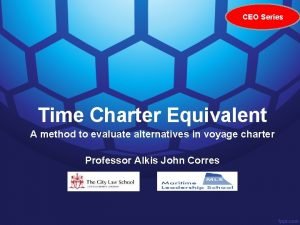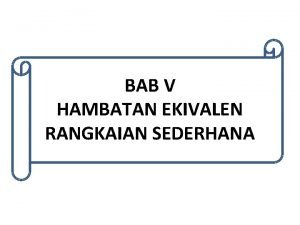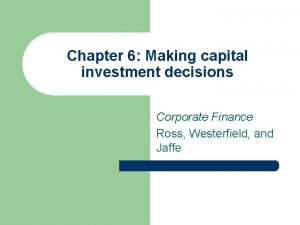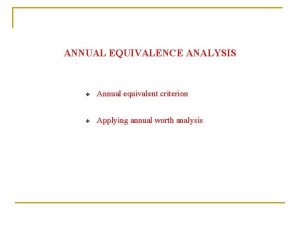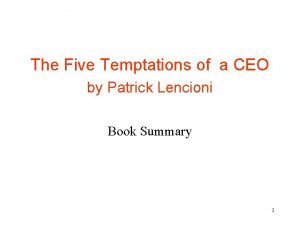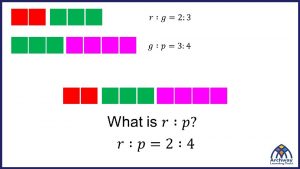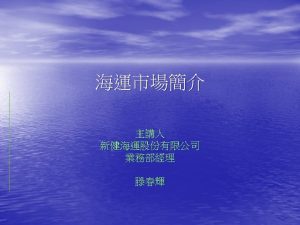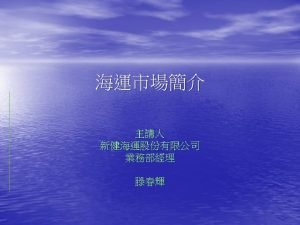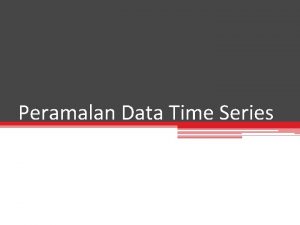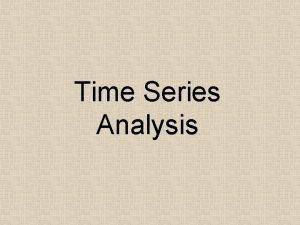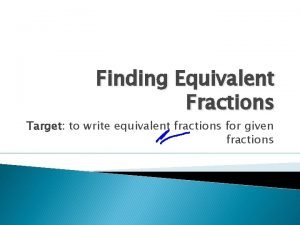CEO Series Time Charter Equivalent A method to

















- Slides: 17

CEO Series Time Charter Equivalent A method to evaluate alternatives in voyage charter Professor Alkis John Corres


Time Charter Equivalent (TCE) is a calculation method that facilitates business decisions in ship chartering. Chartering alternatives in the spot market brought for evaluation by brokers to a ship operator can be puzzling. High freight rates can hide losses and vice versa as the mix always involves: Ø Ø Different cargo intakes Different ports of load/discharge with/without draft restrictions Different distances Different freight rates/commissions, and so on. TCE calculation removes uncertainties and ranks alternatives on basis of daily yield. TCE does nothing more than convert each and every one of the alternative voyages into hypothetical time charters so that daily rates can be compared. TCE should only be used as a facilitation tool, as there may be other factors at play, outside the calculation, that can lead to a different choices than the highest TCE obtained.

The process of calculation is best explained with an example. Let us assume our ship has just discharged her cargo at Eleusis Bay in Greece and has been shifted to the roads of Piraeus, free from charter obligations. . The ship is a five years old double hull, 40, 000 dwt clean products tanker built to IMO III specification with epoxy coated cargo tanks, oil majors approved, otherwise described as follows: q q q q Cargo tanks capacity (100% full): 45, 300 M 3 Main Engine: 8, 580 KWx 127 rpm Service Speed: 15. 0 knots on 32. 8 HFO ton/day. Cruising Range: 16, 000 nautical miles Cargo Unloading Rate: 3, 000 M 3/hour Generating Engines: 3 x 740 KW on 2. 8 tons HFO each Last three cargoes: Aviation Kerosine (JP 1), Diesel Oil, Lead Free Gasoline. (The above specs have deliberately been kept to a minimum to facilitate calculations).

Cargo brokers have been contacted to seek suitable employment for this vessel which owners wish to trade in clean petroleum products and/or easy chemicals. It is Monday, January the 30 th 2017 today and the brokers have come up with the following suggestions: v Voyage A: Full cargo of Unleaded Gasoline, loading Constanta (Romania), discharge Rotterdam, laycans February 1 st/ 6 th 2017, charterers’ ideas USD 15 per ton, total commission 2. 5%, Laytime 54 hours SHINC (Sundays Holidays Included) Shell. Voy 4 charter party. Demurrage $ 20, 000 per day pro rata. v Voyage B: Full cargo of Jet A 1, load Eleusis discharge Dar es Salaam (Tanzania), laycans spot prompt, charterers’ ideas USD 27 per ton, total commission 3. 75%, Laytime 96 hours SHINC, BP Voy. Demurrage $ 23, 000 per day pro rata. v Voyage C: 30, 000 MT + or- 1% in charterer’s option of easy chemicals (MTBE is an additive to petrol) Methyl Tert Butyl Ether , loading Marsa el Brega (Libya), discharge Lagos (Nigeria). Laycans January 30 th/February 3 rd 2017, charterer’s ideas USD 29 per ton, total commission 3. 75%, Laytime 120 hours SHINC. Demurrage $ 24, 000 per day pro rata.

We now accept that the final outcome of negotiations will be in every case very close to charterer’s ideas, berthing on arrival in all cases, so that we can start to calculate TCEs. VOYAGE A CONSTANTZA/ROTTERDAM

VOYAGE A CONTINUED • • • Ballast voyage to Constantza via the Sea of Marmara: 713 miles, 2. 5 days at an average of 12 knots (including Bosphorous). The vessel must receive bunkers and fresh water prior departure. Constantza-Rotterdam 3, 956 miles, 11. 8 days@14 knots average. Bosphorous northbound charges: …………USD 5, 200 Constantza port agency expenses: ………. . USD 18, 000 Southbound Bosphorous Charges: ………. . USD 5, 200 Agency expenses in Rotterdam port: ……. . . USD 21, 000 TOTAL AGENCY EXPENSES (Estimates)……. . USD 49, 400 Total days: (2. 5 ballasting+ 2 load+11. 8 sail+1. 5 discharge) = 17. 8 Sailing days: (2. 5+11. 8) = 14. 3 Fuel consumption: (14. 3 d*32. 8=469 tons+17. 8 d*2. 8=49. 8 tons), Total 519 tons of Heavy Fuel Oil. For the sake of simplicity we do not take into account the need to burn gasoil in the short distance of the Special Emissions Control Area.

VOYAGE A CONTINUED • With 45, 300 M 3 cubic capacity at 100%, the vessel can take in only 32, 616 tons maximum (Specific Gravity of Gasoline 0. 72). • Freight income: 32, 616 tons*$15=$ 489, 240 minus 12, 231 commission, net freight income $ 477, 009 • Cost of bunkers USD 325 per ton in Piraeus: 519*325=USD 168, 675 Therefore, Agency $ 49, 400+ Bunkers $ 168, 675 = $ 218, 075 • So, $ 477, 009 minus $ 218, 075 expenses = Net Earnings $ 258, 934/ 17. 8 total days, TCE $ 14, 546

VOYAGE B ELEUSIS/DAR ES SALAAM

VOYAGE B • No ballast voyage, loading at HELPE refinery, Eleusis Bay. • Laden voyage leg to Suez Canal Port Said 863 miles@14 knots, 2. 6 days. • Suez canal crossing: One day. • Suez (Ismailia end) to Dar es Salaam: 3, 332@14 knots, 9. 9 days. • Sailing days: 2. 6+1+9. 9= 13. 5 at 32. 8 tons per day, 442 tons. • Total days: 13. 5+2 load+2 discharge = 17. 5 • Generating engines: 2. 8*13. 5+4*2. 8=49. 0 tons. • Total fuel consumption: 491 tons HFO@ $325=$159, 575 • Agency expenses (Estimates): Eleusis: $ 20, 000, Suez Canal Dues: 110. 000, Dar es Salaam: 28, 000. • Total agency expenses= $ 158, 000

VOYAGE B Thus we have… • JP 1 has a specific gravity of. 79 therefore max loading 35, 787 tons. • Freight income: 35, 787*27=$ 966, 249 minus $ 36, 234 (3. 75% commission) = $ 930, 014 • Freight income net of commissions: $ 930. 014 • Minus expenses (agency 158, 000 + bunkers 159, 575)= $ 317, 575 • Net Earnings $ 612, 439 Net Earnings: $ 612, 439 /17. 5 days = TCE $ 34, 996

VOYAGE C MARSA EL BREGA / LAGOS

VOYAGE C • Ballast voyage from Piraeus Roads to Marsa El Brega : 613 miles @ 14 knots = 1. 8 days • Laden voyage from Marsa el Brega to Lagos: 5, 069 miles @ 14 knots = 15. 1 days • Sailing days: 1. 8+15. 1= 16. 9 • Total days: 1. 8+15. 1+4 = 20. 9 • Delays are common at the port of Lagos, current reports mention delays up to two weeks before berthing. • Bunkers: 16. 9*32. 8= 554. 3 tons, plus 20. 9*2. 8= 58. 5, total consumption 612. 8 tons HFO @ $ 325 = $ 199, 166 • Agency expenses (Estimates): Marsa el Brega $ 29, 000, Lagos $ 35, 000, $ 64, 000. Total expenses: $ 263, 166

VOYAGE C • MTBE has a specific gravity of 0. 74 therefore the 30, 000 min/max will occupy 40, 540 M 3 of the vessel’s capacity (about 89%). • Freight income: 30, 000 MT*$ 29= $ 870, 000, minus 3. 75 % commission $ 32, 625, Net Freight Income $ 837, 375 • Net Freight Income : $ 837, 375 • Minus Expenses (agency $ 64, 000 + bunkers $ 199, 166) $ 263, 166 • Net Earnings $ 610, 209 Net Earnings: $ 610, 209/20. 9 days = TCE 29, 196

Let us now recap. • • • Voyage A to Rotterdam: ………………. . …. TCE $ 14, 546 Voyage B to Dar es Salaam: …. …… TCE $ 34, 996 Voyage C to Lagos……………. TCE $ 29, 196 Comments on further trading Evidently Voyage B gives the highest TCE, however the local refinery (TIPER) has had problems for a long time and low production. Since other refineries nearby also have problems a ballast voyage to Ras Tanura refinery in the Red Sea (9. 5 sailing days) may be needed to find a cargo. In such a case, total days would become 30. 4 with an addition on the fuel bill of 9. 5*32. 8 tpd=311 t+26. 6 t =337 t*$ 325 = $ 109, 720. Expenses would rise to $ 436, 886, net earnings down to $ 400, 489 and TCE ($ 400, 489/30. 4 d) would shrink to $ 13, 173. Voyage C also pays good money. Nigeria has four refineries, two in Port Harcourt (PHRC), and one each in Kaduna (KRPC) and Warri (WRPC). Finding next cargo of clean petroleum products in the region should not be difficult. Voyage A ends in Rotterdam where finding a next cargo will be easy.

The final choice belongs the owners of the vessel. In case one wants to have an idea about the relative profitability of the alternatives, all he has to do is insert the Operating Expenses of the ship in the calculation. Therefore, assuming the daily opex for this type/size of ship are USD 5, 300 (excluding any financial expenses and depreciation), profitability would be as follows: Voyage A: $ 258, 934 minus $ 94, 340 opex = $ 164, 594 profit, daily average $ 9, 246. Voyage B: $ 612, 439 minus $ 92, 750 opex = $ 519, 689 profit, daily average $ 29, 696 Voyage C: $ 610, 209 minus $110, 770 opex = $ 499, 439 profit, daily average $ 23, 896 In case the ballast voyage to Ras Tanura becomes necessary after discharging the profit would be ($ 400, 489 minus 9. 5 d*5300=50, 350) $ 350, 139 daily average $ 11, 517.

One should also be aware that profitability and TCE can change for the worse in some cases. Namely, • When days are lost due to lack of next charter. Long waiting spells at anchor can destroy the results of the best fixtures. • When relocation through ballasting becomes necessary. The choice between waiting for a few days more in hope of a charter and ballasting back (or forward) can take in some cases agonizing proportions. • When return voyages can only be fixed at loss making rates. This happens more frequently than one would imagine. • Accidents and breakdowns of all sort have a direct impact on outcomes. END
 Charterbare
Charterbare What is time charter equivalent
What is time charter equivalent R ekivalen
R ekivalen Relationship between energy and current
Relationship between energy and current Start time end time and elapsed time
Start time end time and elapsed time Maclaurin series vs taylor series
Maclaurin series vs taylor series Balmer series lyman series
Balmer series lyman series Maclaurin series vs taylor series
Maclaurin series vs taylor series Taylor series lesson
Taylor series lesson Ibm p series
Ibm p series General feedback
General feedback Series aiding and series opposing
Series aiding and series opposing Arithmetic series vs geometric series
Arithmetic series vs geometric series Working capital investment example
Working capital investment example Annual equivalent worth formula
Annual equivalent worth formula Importance of symposium for students
Importance of symposium for students Sus ceo
Sus ceo The five temptations of a ceo summary
The five temptations of a ceo summary

